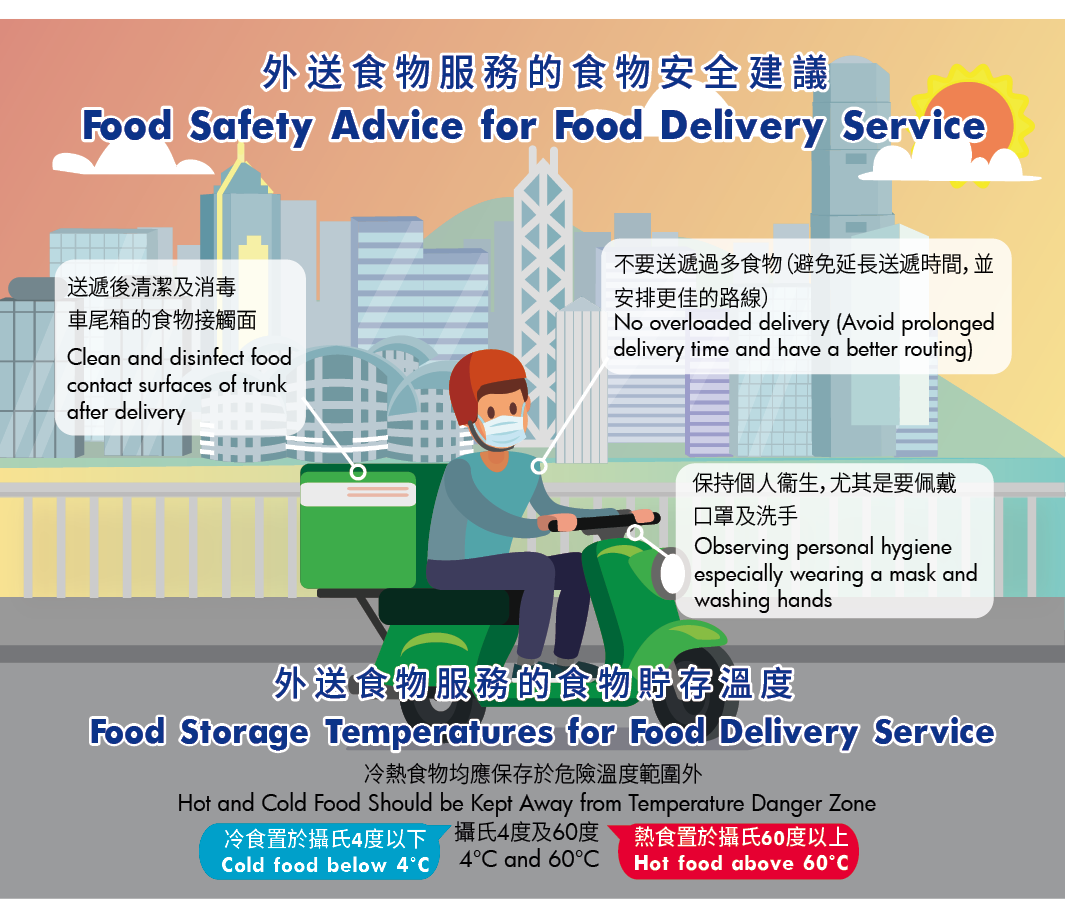
Food Safety Focus (170th Issue, September 2020) – Food Safety Platform
Let's Join Together: Uphold Food Safety of Food Delivery
Reported by Mr. Allan YUEN, Chief Health Inspector,
Risk Communication Section, Centre for Food Safety
Background
Upon the on-going COVID-19 epidemic, food delivery from food premises is becoming more popular. With the advance of mobile applications and technology, food orders can be easily made at people’s fingertips. Involving a number of handling procedures from the kitchen to the customers’ table, food delivery can however raise concerns on food safety risks arising from a lack of suitable temperature control and risk of cross-contamination throughout the delivery procedures. Food operators, delivery service staff concerned and customers have to join hands to ensure the delivery of food safe for human consumption.

Figure 3: Proper hygienic practices and temperature control for food delivery service
Food Safety Risks of Food Delivery from Restaurants
It is not uncommon for food operators to prepare food in advance to cater for the surge in demand during peak hours. Partially processed ingredients or cooked meal sets will be stowed for some time till being finally reheated and packed for delivery. The longer the time for food preparation, delivery and customers’ deferred consumption, the higher will be the risk of the growth of food-poisoning bacteria of the food left within the temperatures between 4°C and 60°C, the temperature danger zone. In addition, distorted and improperly sealed packaging, inadequate thermal insulation of food containers and unhygienic handling such as tampering the food by dirty bare hands or altering the packaging in the course of delivery also pose risks of cross-contamination of the food.
Tips for Safe Food Delivery
Although advanced food delivery mobile applications enable food caterers to take more orders from scattered locations, both food caterers and delivery agents should pay heed to monitoring real-life hygienic practices of staff on food storage and delivery. The Hazard Analysis Critical Control Point (HACCP) plans or HACCP-based food safety systems are well-recognised and effective tools for the food delivery services to systematically analyse and identify possible control points against different food hazards from food preparation, packing and storage to, finally, delivery. Risk control points should be focused on food hygiene during preparation, food temperature control and hygienic measures to secure cleanliness of all food contact surfaces during food delivery.
Advice to Food Business Operators
Food handlers should adopt the Five Keys to Food Safety and implement the HACCP system, or follow its principles, to ensure food safety. On food handling, food business operators should also prepare food timely to match the delivery. Staff have to practise hand hygiene by washing hands before handling food for delivery. Good thermal insulated delivery containers of durable materials with fitted covers should be used. Store food packs in a clean and dry designated area pending delivery. Cold and hot food packs should not be put together in the same bulk container to avoid undesirable temperature maintenance.
Advice to Food Delivery Service Providers
Food delivery agents should safeguard food against cross-contamination by hygienic transportation means and close monitoring of the right storage temperature. The service management should control strictly its delivery capacity by checking the time record against any delayed deliveries. Well-organised logistics can also shorten the food delivery time.
Contact surfaces of delivery containers and motorcycle storage compartment like rear trunk or tail box case should be cleaned by sanitisers, disinfectants or liquid soap thoroughly before and after each delivery.
Store cold and hot food separately in insulated bags and keep hot food at above 60°C and cold food at or below 4°C. Installation of thermometers for temperature records at containers and food storage compartment are useful for validating food temperature control measures. Staff are reminded to organise well the delivery load to minimise unnecessary ransacking and exposing the food packs at ambient temperature.
Advice to Consumers
The public should place orders of appropriate food amount from reliable suppliers or catering premises of close proximity to avoid long-haul delivery. Consumers are encouraged to order thoroughly cooked food from food delivery service. Delayed delivery or food with noticeable packaging defects should be rejected. Delivered food has to be consumed immediately, whereas leftovers should be handled according to the two-hour and four-hour principle.


